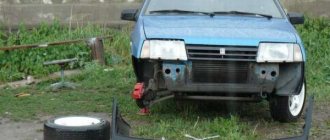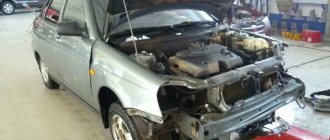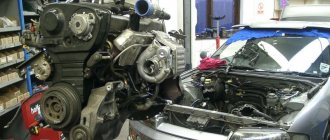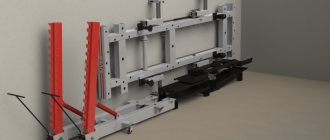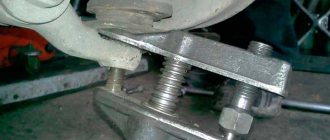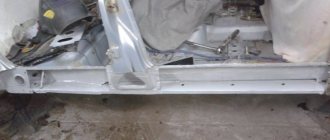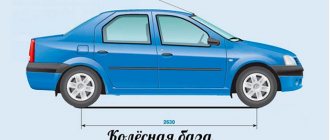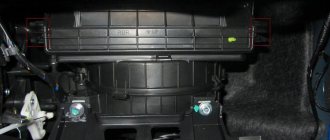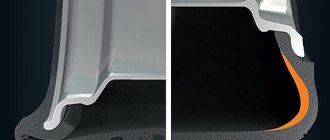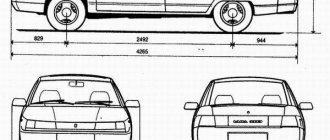Tire studding is a standard procedure aimed at improving the performance of winter tires for safer driving in cold weather.
Below we will consider what kind of process this is, and what goals the car owner pursues, and we will talk about the pros and cons of the procedure. We will separately consider which tires can be studded, and in which cases it is better to abandon this procedure.
For convenience, we will present the process of preparing and installing spikes, analyze step-by-step instructions for action, discuss technologies and their differences, stages of work and much more.
What is tire studding and why is it needed?
Tire studding is an activity aimed at installing studs in a winter tire in the factory holes or without them. In the latter case, an operation is performed to create recesses using special equipment.
Goals:
- ensuring controllability in winter;
- improving the quality of grip when traveling on icy roads;
- savings on tires.
In some cases, studding improves the characteristics of the rubber, but this does not always happen. In addition, the installation of aluminum inserts is not always permitted by law. We will dwell on this issue further below.
Make your own stud gun
In winter, for good grip on the road, it is better to install studded tires on your car. There are several tire options on sale from different manufacturers, the rubber differs in quality and price. If for some reason you do not have the opportunity to purchase studded products, you can make them yourself from regular all-season tires. So, how to successfully make a spike with your own hands? The technical characteristics of rubber depend on the location of the studs, their number and size. Despite the large time-consuming and labor-intensive process, in some situations it will be more profitable to do the stud work yourself.
Is it possible to stud summer and all-season tires?
In practice, there are a number of restrictions regarding studding of winter tires.
Installation of spikes is permitted if the following conditions are met:
- the product has special holes for fastening metal elements;
- depth of the residual part of the tread - from 7 mm or more;
- the tire has high-quality recesses for installation;
- the all-season tire has an M+S projector;
- tires are installed on special equipment (seasonality does not matter).
Studring is prohibited:
- on all-season tires in the absence of the necessary grip characteristics for winter driving (there are exceptions);
- in the tread of friction tires due to the shallow depth and finely cut lamellas;
- on a summer tire: this is pointless and prohibited by law.
Before studding all-season or winter tires, determine the relevance and feasibility of the work, and then begin the process.
Re-studding
This procedure is new. With its help, you can increase the life of a tire without significant costs. Re-installation of studs is carried out on winter tires that contain worn elements and empty holes. You need to buy special spikes that are designed specifically for this type of work. Such elements have a large cap, which allows them to hold well in empty, stretched holes. The design of such spikes has the following structure:
- metal body;
- plastic sleeve;
- a tip for which especially hard alloys are used.
Advantages and disadvantages
Installing studs or re-studding tires is a special process that requires a careful approach, studying the pros and cons.
Positive points:
- Improved handling.
- High-quality grip on slippery road surfaces.
- Reducing braking distance.
- Elimination of skidding when entering turns.
- Absence or reduction of slipping when starting to move.
Weak spots:
- Increased noise, vibration, vibrations and problems with damping the latter.
- Reduced smoothness of movement.
- Accelerated tire wear due to frequent trips on asphalt roads.
- Deterioration of comfort.
- Gradual wear of the inserts with the need to replace them.
- Need for additional balancing.
In what cases should you refuse studded tires?
In an effort to improve the car's handling, car owners often rush to install studs. But sometimes it is better to refuse such a procedure. In particular, experts do not recommend studding worn or damaged tires.
This is due to the deterioration of the tread characteristics, which are unable to hold the studs during sudden braking.
During normal operation, the main characteristic is the depth of the pattern, but in emergency situations, the condition of the tire matters. If you have been using tires for more than one season, it is better to avoid studding. The final decision is made by the technician at the service station after inspecting the tire.
The second situation when installing studs is not recommended is after purchasing tires with new, not yet “broken” holes. If you do not follow this recommendation, there is a high risk of tire damage or the appearance of microcracks that impair traction.
Is it possible to make spikes yourself?
Theoretically, it is possible to manually make elements for studding rubber. But in practice it is not worth implementing this idea. Such homemade elements will be of very low quality, their fixation in rubber will be weak, and installation will be problematic. Ready-made elements for tucking are not that expensive, even if we take into consideration products from well-known manufacturers. In the process of their manufacture, a special alloy with a complex formula is used. Even similar and fake studs are subject to rapid wear, which entails rapid destruction of the rubber. In a word, we do not recommend making your own elements for tucking.
Independent studding has a right to exist. It won’t be easy or quick, but the end result is worth all these difficulties, time and money. We advise you not to give up this idea.
Spike device
When choosing an insert for studding, it is important to understand that it comes in different shapes and types, distinguishing the product by its design features.
By number of flanges:
- Single flange. Structurally, there is one flange that fixes the tenon in one place. It is characterized by the greatest simplicity of design, low noise, but at high speeds they can jump out of the recess.
- Double-flange. Outwardly they resemble a glass, so they are better fixed in the tire and are used in most cases.
- Tri-flange.
The following types differ in form:
- round: universal option;
- cross-shaped: quickly grind down;
- diamond-shaped with six edges: resistant to abrasion, equipped with a special cushion to reduce noise when moving;
- oval: characterized by improved grip on icy surfaces;
- seven-sided: they look like a bucket, guarantee a quick start, suitable for sports cars;
- diamond: pentagonal, have a high price;
- tetrahedral: quickly erased, similar in characteristics to the round version;
- triangular: made in the shape of a triangle, quickly erased;
- trapezoidal: the spike is triangular in shape, and the top is trapezoidal, a universal option for different types of roads;
- three-beam: made in the shape of a star, there is a high risk of slipping when starting to move;
- faceted diamond: provide good grip in different conditions, equipped with a protective cushion.
Differences between repair and factory studs
Structurally, the studs installed in repair shops and at the factory have slight differences.
Let's highlight the main points:
- Dimensions. The repair version has a height of 12 mm, and the factory version is 8 mm (sometimes up to 11 mm). The length of the product installed at the factory does not depend on the shape (section). When repair studding, the choice is made individually, taking into account the type and condition of the rubber.
- Plastic sleeve. This element is present in repair studs and provides an improved seal in the old hole. Its task is to protect the hole from dirt and reagents from the road. As a result, the service life of the stud increases.
- Material of casing and internal part. Since 2016, studded tires at the factory have been installed only with aluminum products. This is due to the weight requirements of the Technical Regulations of the Customs Union. Repair studding involves installing steel or aluminum studs.
Choice of studs
There are different spikes, but round, diamond-hexagonal, diamond and faceted-diamond, seven-sided ones are considered to be of better quality. The most universal ones are round, they are easier to find in stores. Diamond-hexagonal ones are not much different from round ones: only with a cushion that allows you to move silently. Diamonds are expensive, but this is their only drawback. Faceted diamonds are usually found on Continental tires and have good grip on the road surface. Heptagonal ones are used on sports cars because they can be used to start quite quickly. The remaining types wear out quickly and are similar to the round ones, although the oval ones are necessary when there is ice on the road.
To stud winter tires, it is important to consider the material from which the studs are made. Soft alloys will quickly lose their shape if the driving style is harsh, so iron parts are better suited. It is also important how they are attached to the rubber. For this, multi-flange or double-flange ones are more suitable, which have 2 extensions at the base, which increases the reliability of fixation.
What you need to know before performing work
Before you start studding, keep a few important points in mind.
Let's highlight the basic rules:
- The procedure is relevant before the start of the winter season. It is important that the finished tires sit for two to three months before use.
- An important point that affects the service life of rubber is the correct running-in. It is recommended to travel on roads at a speed of no more than 80-90 km/h for the first 400-500 km after studding.
- When choosing the number of studs, you need to look at the radius of the tire. For example, for 13-inch tires you need 90-95 units, for 14-15-inch wheels - 100-110, and for 16-17-inch wheels - 150-165.
- The price of a spike is in the range from 10 to 15 rubles. Some companies offer a flat rate for tuning, regardless of the number of additional elements. As a rule, the price is 600-650 rubles.
Understanding the above rules allows you to extend the life of a studded tire and increase the safety of its use.
What are the best spikes to choose?
Many people believe that spikes are the same type of products that do not differ from each other. Actually this is not true. Today there are many varieties of thorns and they may differ in the following characteristics.
- The body material of the “claws” can be made of aluminum alloys (marked AD), steel (SD) or plastic (MD);
- The shape of the products can be classic round, oval (OD), tetrahedral, diamond (DD) and so on. In fact, there are many more forms, these are just the main ones, the most popular;
- Spikes can be single-flange or double-flange. The latter are characterized by increased reliability, but it makes sense to install them only if you like to drive quickly along highways at high speeds;
- The type of core can be tubular, rod or other type. To put it simply, a single-flange tenon can be either round or oval, while a double-flange tenon has the shape of a “glass.”
This is interesting: Installing a towbar on a Hyundai Solaris
There are no universal models of studs, so when choosing products it is important to understand three important parameters for yourself: what speed you drive, what your driving style is and what characteristics the selected tires have (tread, hardness, etc.).
Important! The stud should not protrude outward from the tire by more than 1.3 mm. Therefore, it is necessary to purchase spikes of the appropriate length.
It is worth noting the number of spikes that can be installed. In fact, there are no restrictions on the territory of the Russian Federation, but most motorists prefer to adhere to European standards, according to which the following restrictions exist:
- It is recommended to install no more than 90 pieces on 13-inch wheels;
- 14-15 inches – 110 pieces;
- 16-inch – 150 pieces.
In addition, remember 2 important rules:
- Studring must be done before the onset of the winter season. New studs need to sit for some time (preferably 2-3 months), in this case they will last longer and will stay firmly in the tire;
- Studded tires need to be broken in. To do this, the first 500 km must be driven at low speed without strong jerks or braking.
Once the equipment for studding winter tires has been prepared, you can proceed directly to the installation process itself.
Studring winter tires with your own hands
There are two methods for studding a winter tire; let’s briefly look at their features:
- Installation using improvised tools using ordinary spikes. In practice, installation can be done using a screwdriver, pliers and a hammer, but there is no talk about the quality of the result obtained.
- Installation of repair spikes using special equipment. Here, instead of a hammer, an air gun is used. Its action is aimed at moving the edges of the hole at the required angle. In addition, before performing work, the rubber is prepared, and the openings are cleaned of any contamination using compressed air. If this work is not done, there is a high probability of misalignment and rapid falling out of the aluminum insert.
To install studs, hire experienced specialists. In the absence of knowledge in this matter, it is difficult to count on good quality installation. Installation in a garage using artisanal methods leads to disastrous results.
Hand tucking
To drive spikes into the tread, you need to use a piece of thick board as a stand for it. It should be placed on the workbench and secured to it with a nail or self-tapping screw. For ease of use, the upper end should be slightly above the waist. So, let's sizzle.
- Wash the tire. Clean the stud holes from any dirt.
- Place the tire on the end of the board.
- Take the mandrel in your left hand.
- Wet the spike with soapy water. Never use machine oil for lubrication. It will destroy the rubber around the stud, so that the stud will not stay in place for long. If there is enough oil, then through damage to the tread is possible.
- With your right hand, moving the rod up, place the spike in the lower part of the tube.
- Place the mandrel with the spike on the hole perpendicular to the tread.
- Take your hammer and with one blow on the end of the rod sticking out from above, drive the tenon into the rubber.
- If the hole is too wide and the repair tenon does not stay in it, no amount of glue will help. Find a suitable place nearby, poke a hole with a thick awl and drive a spike into it.
We hope that studding tires with your own hands no longer seems unrealistic to you.
Preparing equipment and tools
To perform the work, tenoning equipment is required. With its help, products are inserted and fixed in special holes. The operating principle of the tool is based on pneumatic and electric power.
There are three types of stud devices:
- manual;
- semi-automatic;
- automatic.
Hand tools are in greatest demand due to their affordable price. It comes in two types - with a rod that drives a spike, or a pushing device.
The first option is more universal, because it can be used to drive different types of inserts.
Devices with a pusher are usually used for mounting single-roller rods. They are highly efficient and have a long service life.
Popular models of air guns include:
- Sibik Psh-8 is a tire repair device with a working pressure of 7 bar and an air flow of 10 liters per minute. The product has relatively small dimensions: 26.5x26.5x6.5 cm. Weight - 1.87 kg. The body is made of light alloy structures with a protective coating and convenient operation. The diameter of the installed spikes is 8 mm, and the height is from 10 to 13 mm. The largest number of spikes used in the device feeder is 10.
- K-130 Sivik is another air gun for studding winter tires. Made of metal, has a working pressure of 7 bar and an air flow of 10 liters per minute. The length, width and height are 23x22x17 cm respectively. The weight of the structure is 1.7 kg, and the warranty period is one year. As in the previous case, this model works with spikes with a height of 10 to 13 mm and a diameter of 8 mm.
- Rotosystem 8 mm Scason is an Italian-made semi-automatic tenoning machine, powered by a voltage of 220 V. It has a length, width and height of 37x37x25 mm, respectively. The weight of the device is 4 kg, and the warranty is 1 year. The stud guns from this company are simple and easy to use.
- There are plenty of other models on the market.
Device for installing repair spikes 12-8-2tr, 12-9-2tr
I would like to dwell separately on this device. It is intended for manual tenoning into old holes of TEKOM tenons of sizes 12-8-2TP and 12-9-2TP. It can be used both at service stations and in garage conditions.
Structurally, a pneumatic tool for studding tires consists of several elements.
Let's briefly look at their features:
- All metal flask. It is easy to implement, so there is nothing to break.
- The front part has a hole for loading spikes.
- Tips, antennae (guides). With their help, the elements of the winter tire are moved apart and the metal product is fired.
The operating principle of an air gun is simple. Special jaws (antennae) push the edges of the seat and mount the stud without compromising the integrity of the tread. When using the tool, a pressure of 10 bar is used, so a compressor is required for operation.
Also, in some cases you will need a medium-sized rubber mallet; using a metal hammer is not recommended.
Tools required for studding
In order to carry out tucking without a pneumatic gun, a minimum set of tools is required, which is presented in the table below.
Table - Tools for studding tires
| Name | Note |
| Container with soap solution | To wet the tread |
| Multiplier | Manual or electric. In extreme cases, you can replace it with a rag, sponge or brush |
| Hammer | Required if it is necessary to drive in spikes |
| Round nose pliers or narrow nose pliers | To widen the holes for inserting tenons |
| Screwdriver | For fixing the spikes in the seat |
| Pliers or pliers | Required for removing old tenons or new ones in case of improper installation, for example, misalignment |
To speed up the studding process without a pneumatic gun, you can use a screwdriver. This method is called semi-automatic. A screwdriver allows you to screw in tenons to the same required depth in a short period of time.
Many drivers have a question: “How to stud tires yourself?” First of all, you need to prepare tools and materials. Most of the work is done with an electric drill. You will also need a special attachment in the form of a drill of a suitable diameter, which will allow you to make holes on the tire.
To install the spikes you will need:
- hammer;
- pliers;
- metal plate;
- screwdriver;
- calipers;
- soap solution.
Installation can also be carried out using a pneumatic gun. It works due to a special compressor, which, under air pressure, drives the spike into the desired hole.
Can I use a drill and an awl?
Sometimes a drill is used for secondary tenoning. But experts do not recommend using the services of service stations that use this technique. Service employees save money, but do not worry about the safety of clients. A drill cannot guarantee the safety of rubber or safe studding.
It is also not recommended to use an awl, because you can accidentally miscalculate the force and puncture the tire through.
If the manual method is chosen, it is necessary that all holes be identical to the tenon length of 9 mm, and the depth of the groove itself is 8-9 mm. If necessary, measurements should be taken using a caliper.
Drilling a winter tire must be done very carefully, because there is a high risk of drilling a hole through.
Difference between technologies
Car owners are often confused about technology and do not understand that studding tires with openings provided by the manufacturer is different from installing repair studs.
There are two features here:
- To restore old wheels and studs, different types of studs are used. Points for installation on used products are already provided, so the repair spikes also have a larger base. A polymer sleeve is also provided here, which allows you to seal the product in the socket. In addition, the design parameters and characteristics of the studs are almost no different from the factory ones.
- When repairing and installing into existing sockets, various types of equipment are used. In budget service stations, when performing work, a standard drill with drills of the required length is used. There, as a second tool, an air gun purchased on the secondary market and which does not perform its functions well can be used. As a result, when performing work, the hole is severely broken and there is a high risk of damage to the tire. As a result, grip on the road may deteriorate and the service life of the products themselves will decrease.
Do-it-yourself winter tire studging without an air gun, video
Every year, as soon as it becomes clear that autumn has already passed, city car owners begin to get sets of winter tires. Its inspection usually shows that after the last season of operation, not all the studs remained in place. It’s good if the owner knows that it is possible to stud winter tires with his own hands. Otherwise, he will use what is left or buy a new winter set. To assess the suitability of a cylinder for use, you need to know that a winter tire must be studded in such a way that there are at least eight studs on the contact patch with the road surface.
Number of studs in the contact patch
For a passenger car weighing about 1.2 tons, the weight per wheel is 300 kg. With a tire pressure of about 2 kg per cm2, the contact patch area will be approximately 150 square meters. cm. This means that the tread of a new studded tire with a width of 155 mm should have 8 studs for every 10 cm of circumference. For satisfactory grip, loss of no more than 20% of the studs is allowed. That is, 6–7 spikes may remain in the contact patch. If you have less of them left, the tire needs to be studded. Before doing this, measure the remaining tread height. A tread height of less than 4–6 mm indicates that the tires should not be studded, but replaced with new ones.
Anti-slip stud device
All studs for serial passenger car tires consist of a body and a carbide core protruding from it. For better retention of the tread rubber, the body has 2-3 flanges. The material for their manufacture can be either steel or plastic. The flanges of the repair studs have a slightly larger diameter than regular ones. Since flanges of the same diameter will not be held by a broken hole.
Tenon mandrel design
The mandrel consists of two parts:
- A thick-walled metal tube with an internal diameter slightly larger than the diameter of the repair tenon flanges. Its length should be several centimeters greater than the width of your palm.
- A piece of steel rod that fits tightly into a tube. It is necessary that its length be equal to the length of the tube.
Hand tucking
To drive spikes into the tread, you need to use a piece of thick board as a stand for it. It should be placed on the workbench and secured to it with a nail or self-tapping screw. For ease of use, the upper end should be slightly above the waist. So, let's sizzle.
- Wash the tire. Clean the stud holes from any dirt.
- Place the tire on the end of the board.
- Take the mandrel in your left hand.
- Wet the spike with soapy water. Never use machine oil for lubrication. It will destroy the rubber around the stud, so that the stud will not stay in place for long. If there is enough oil, then through damage to the tread is possible.
- With your right hand, moving the rod up, place the spike in the lower part of the tube.
- Place the mandrel with the spike on the hole perpendicular to the tread.
- Take your hammer and with one blow on the end of the rod sticking out from above, drive the tenon into the rubber.
- If the hole is too wide and the repair tenon does not stay in it, no amount of glue will help. Find a suitable place nearby, poke a hole with a thick awl and drive a spike into it.
We hope that studding tires with your own hands no longer seems unrealistic to you.
How to save thorns
Many sources advise running studded tires on dry and clean asphalt, without waiting for snow and cold weather. The need for break-in is motivated by the fact that during this time the studs will fall into place and the technological lubricant will be erased from the tread. You think that you are buying good tires, but their studs are out of place and the tread is greased - one of my friends once said when he learned about this. Break-in recommendations usually contain extremely useful advice, ranging from the fact that during this time you should not exceed the speed limit, ending with a warning not to run over curbs.
Please note that the studs hold the car well, clinging to the ice, but they do not dig into clean asphalt, therefore, as many drivers note, they greatly impair traction.
Manufacturers' recommendations
To ensure that your tires have more studs left at the start of the next season, use them in the conditions for which they are intended. Follow the manufacturer's recommendations. Here's what the Goodyear website says about winter tires. They are designed to operate in temperatures below 7°C and in harsh winter conditions. Winter tires use technologies that improve traction and braking on snow and ice-covered surfaces. However, on their website there is not a word about the need for break-in. The warranty conditions for Nokian Tires products also do not mention running-in. However, an online consultant on this company’s website told me the following: “The optimal temperature for replacing summer tires with winter tires is in the range from +5 to +7 degrees Celsius. After installing the tire, it is recommended to break it in immediately. Break-in occurs during the first 500–800 km. During this period, you should not brake sharply or start moving; the speed should not exceed 80 km/h. It is also contraindicated to maneuver vigorously, quickly changing the direction of movement.”
Any manufacturer indicates restrictions on permissible speed and wheel load on the side surface of the tire. You just need to be able to read them. We are talking about the load index and speed. They are indicated next to the tire size.
Limit parameters
The load index is indicated by a two-digit number. Index 50 indicates the permissible load on the wheel is about 190 kg. Each unit added to the index number increases the load capacity by 5 kg. That is, 51–195, 52–200 and so on.
The speed index is presented in the form of letters of the Latin alphabet. J – 100 km/h; K – 110 km/h; L – 120 km/h; M – 130 km/h. Each subsequent letter increases the permissible speed by 10 km/h.
Determine the maximum permissible parameters and do not exceed them. Then there will be more thorns on the tread by next winter.
autolirika.ru
Stages of work
The work of introducing studs takes place in several steps, starting with creating or cleaning an existing recess, ending with inspection and balancing.
Check the tread condition
Before performing work, check the condition of the car tires.
To do this, take the following steps:
- Use a caliper to measure the tread depth. As a last resort, use a regular ruler.
- Check the result. For winter tires it should be at least four millimeters, and for summer tires - two millimeters.
If the measurement results in a shorter distance, the tire is too worn or worn unevenly, then it is not suitable for studding.
Signs of a well-made stud
When assessing the quality of work, it is necessary to pay attention to several aspects: the quality of the inserts, the remaining tread, the tool and the technology used.
Let's take a closer look at each of the elements:
- Depth of the drawing. It is optimal for it to be smaller than the shortest repair spike (7 mm).
- Spikes. The repair ship includes a casing, an insert and a special bushing. The flange diameter is 1.2 cm. For comparison, for factory products this parameter is 0.8 cm.
- Tool used. It is important that during the work a pneumatic gun is used, operating under a pressure of 10 bar and requiring the use of a compressor.
In the future, the quality of work is determined by the service life of studded tires and the number of seasons before repair or replacement of rubber.
Features of mounting studs
As practice shows, the most suitable for studding are tires that already have ready-made holes for installing wheel studs. You can find out about the presence of these holes from the markings of passenger car tires. In addition, the holes are clearly visible visually and are large in size, so beginners will not be able to damage the rubber.
To re-stud and re-stud the wheels you will need to stock up on an air gun. With its help, wheel studding will be done quickly and efficiently. During the tucking process, you should pay attention to how much the stud itself protrudes from the surface of the wheel. It is best if the tip of the latter does not stick out higher than 1.5 mm from the tread. Otherwise, the spike will fly out of the hole very quickly. After you have found a gun, you need to decide on the terrain you are driving through.
Pneumatic gun for re-studding
If you spend most of your time moving on a relatively flat road, then single-flange type studs are suitable for replacement. If you use a car in mountainous areas, then the best option would be to install double-flange wheel studs.
Whether you're studding your wheels for the first time or doing it again, you'll need a solution of soap and water. The water must be warm - this will greatly facilitate the passage of the stud into the rubber. The principle is this: before studding, the outer side of the tire is wetted with a solution, after which the studs need to be inserted into the holes of the tire. Particular attention should be paid to working with a pistol. Before adding studs, the separator of the pneumatic device is filled with studs. After that, we get to work. In this case, the position of the gun itself is very important - it must be held strictly vertical in relation to the surface of the tire.
When installing spikes you need to be extremely careful. After they fit into the tire, they need to be measured. If the spike has entered the wheel, but more than 1.5 mm of the entire body of the spike remains above the tread, then you need to take a small piece of aluminum sheet, put it on the screw and hit the metal with a hammer. If after this the stud does not fit into the tire, then you will have to re-stud, that is, install a new element again. In this case, the old spike must be thrown away, since it will no longer be suitable for work.
Other methods that can be used at home
If you have free time and certain knowledge, it is possible to install spikes at home.
Take the following steps:
- Order spikes for installation. Alternatively, you can buy them on Ali Express in special bags of 100 pieces each.
- Place the tire vertically.
- Remove the empty clips from the old studs using duckbills and clean the tread of stones. The latter may affect further wheel balancing. You can use a screwdriver and compressed air to clean it.
- Prepare a tube with an outer diameter of no more than 12 mm and an inner diameter of at least 9 mm.
- Make sure that the hole depth is no less than that required for the tenon.
- Lubricate the prepared openings with a soap solution.
- Install the tenon into the hammer drill and insert them one by one. This method is much more convenient than a drill, because in this case there is less risk of making a mistake.
- Check the product for strength and shrinkage depth. It is optimal for the spike to protrude 1.5 mm or more.
- Dry the tires and store them. It is strictly forbidden to use the tire immediately. This will damage the studs and will invalidate all efforts.
The total time to complete the work with a short lunch break takes no more than five hours.
You can also use the Doshipun device, which simplifies the task.
Instructions for use in the photo.
You can make such an analogue with your own hands.
How to properly stud a car tire with your own hands?
The use of specialized winter tires is a mandatory requirement. Rubber intended for the cold season is more elastic. Adapted to work at extremely low temperatures, it provides better grip on asphalt and difficult surfaces, be it ice or snow.
The summer version will simply freeze in such conditions, the car will begin to slide and skid, and the risk of an accident will greatly increase. In addition to regular winter tires, popularly called “Velcro” tires, there are also special studded models on the market.
The spikes literally “bite” into the ice and cling to the packed snow, which ensures precise control and good maneuverability in the most difficult situations. Unfortunately, when driving on clean asphalt, the studs are subjected to increased mechanical stress, and therefore some of them may simply “fly out”.
Buying a new set of tires is an expensive pleasure; it is not surprising that many drivers have the question of how to restore studs on winter tires on their own? Experts write about this.
How can you tell if a tire needs repair?
Let’s say right away that restoring tire studs is a completely doable operation. If the tread has sufficient depth and the rubber material itself does not show any particular signs of wear, then there is no need to purchase a new set. The repair will allow you to completely restore the original technical characteristics of the rubber, and will also save a large sum of money.
You can determine that a product needs restoration by the following signs: holes are clearly visible on the surface, which were left behind by fallen thorns; there is a large gap between the stud and the tread; metal elements have lost their initial strength of fixation; without much effort they can be sunk inside the tire or loosened; the height of the spikes above the rubber surface has dropped to one and a half millimeters; traces of mechanical stress, abrasion and deformation are visible on them.
What tires can be retreaded?
Replacing studs is relevant and justified if the following conditions are met: The tire was equipped with studs at the factory, that is, it has all the necessary mounting holes, the location of which is strictly thought out and optimized. The rubber is no more than five years old.
After this period, the material begins to age and its properties change. The tread has a sufficient depth of at least 7 millimeters. No serious mechanical defects or other damage that can be determined during a visual inspection. Spikes: design features and principles of selection Visually, a spike is a very simple metal element, consisting of a body and a core protruding from it to a certain length. The body is formed by a fairly soft metal, while the core is as hard as possible, which reduces the intensity of mechanical wear. To achieve maximum fixation strength, the body is equipped with 2-3 flanges.
In order for do-it-yourself repairs and additional studs to give the desired result, when selecting studs you should be guided by several simple principles:
1. Ideally, you should use a rebuild kit recommended directly by the manufacturer. Many companies produce such kits; the metal elements fully correspond to the factory originals, which ensures ease of installation, as well as complete restoration of the original technical parameters of the rubber. Important! If you can’t find such a set on sale, then you can also purchase studs from a third-party brand, but pay attention that in terms of their configuration, production material and other main indicators, they fully correspond to the originals.
2. If you operate your vehicle mainly in the city, drive on asphalt, and rarely drive on ice and other difficult surfaces, then you can opt for simple studs with one flange.
3. For regular trips on ice and country roads, which are rarely cleared of run-up and compressed snow, it is better to install more powerful and reliable metal elements with several flanges.
Mechanized methods
Installation can be done entirely manually or using a special tool. Let's start the analysis with the second option. The most reliable, fastest and most effective tool is an air gun. Yes, it is not cheap, so buying it for one procedure is not the most rational decision.
Using the gun is quite simple, just follow the following algorithm: pumping up the tire; installing a spike in a specially equipped groove on the gun; the working part of the tool is pressed tightly against the mounting hole; the trigger is pulled, under great pressure the element literally “flies” into the socket and is fixed.
An alternative option is a screwdriver (drill with the ability to operate at low speeds), on which a special attachment is installed; you can purchase it in automobile stores.
Manual technique
You can install repair studs for winter tires using the simplest tool. In the process you will need the following: pliers; hammer; a screwdriver with a diameter corresponding to the mounting hole for the tenon; warm soapy water.
First of all, the tire must be thoroughly washed to remove dirt. Next, the entire tread surface is wetted with water so that the studs fit into the holes more easily. Immediately before installing the metal element, the seat is slightly expanded with a screwdriver, and the tenon is also washed with soapy water.
Important! The use of oil as a lubricant is unacceptable, since it is a chemically active substance that can cause destruction of the rubber material. To ensure that the tenon is at the required depth, it is driven into the socket with a hammer or pliers.
If the diameter of the mounting hole is too large, it is worn out and therefore does not provide reliable fixation, a simple and quick repair can be made using a special glue. For example, there is a good glue called Loctite 480.
Watch the video showing the easiest way to stud tires using a screwdriver:
Operating Tips
For tire repair at home to be truly effective, at first you need to follow some operating rules. The main requirement is that the tire must lie in the garage for several days so that the soap solution is completely absorbed into the material and the studs are firmly fixed in the structure of the product.
On your first trips, you don’t need to accelerate faster than 60 kilometers per hour. This speed limit is observed for approximately 300 kilometers. This is enough for the metal elements to be fixed, “grind in” to the material and achieve maximum strength.
In the future, you can use the tires in exactly the same way as immediately after purchase, since their original characteristics have been restored.
What devices are needed for manual re-studding?
In order to stud winter tires yourself, which do not have special holes, you need to find a high-quality drill with a special tubular drill bit. Then all the chips formed during drilling will go inside, and you will not need additional blowing of the holes made.
Be sure to set the limiter correctly, because all the spikes, without exception, must be at the same depth.
A special pneumatic gun connected to a special compressor will help you “plant” the studs into the rubber quickly and efficiently. Pressing the trigger sets in motion special paws that expand the hole, and the element easily fits into the place intended for it. In addition to the compressor, drill and gun, you will need: a set of suitable spikes; hammer and pliers; spray bottle with soap solution.
How to make your own spikes
Making your own studs is a labor-intensive and difficult process. Moreover, experts categorically do not recommend using self-made studs: made from improvised or simply low-quality materials, they wear out very quickly, or even simply fly out, causing significant damage to the rubber. In addition, all the elements must be exactly the same size, otherwise they will be difficult to install and will start flying out of the tire as soon as you drive out of the garage door. For all these reasons, it is better to give preference to ready-made kits from trusted manufacturers.
How to stud tires yourself
So, you decided to make the studs yourself. This is not difficult, and will also save money on service station fees. Most likely, you won't have an air gun with a compressor in your garage, so we'll assume that you only have pliers, a drill, and a screwdriver on hand.
First of all, you should drill holes, as described above (in the event that your tires were not provided with any). Now let's proceed directly to installing the tenons: Carefully wash the mounting area, rinsing both the outside and the inside, removing dust and remaining chips. We measure the depth of the holes made in order to choose the right repair kit. The elements should be slightly shorter than the hole itself. Take a screwdriver and widen the hole enough to push the spike into it.
Sometimes you also have to use pliers for this manipulation. We push the element with force, making sure that it sits tightly and securely, as if in its originally intended place. Upon visual inspection, there should be no noticeable distortions or bulges. We repeat the manipulation as many times as there are studs planned to be installed in the tire.
Many car owners stud tires on their own, because for a successful result you just need to practice a little, and everything will go as it should. An old tire that you no longer plan to use for its intended purpose is quite suitable for this. The main thing is to develop the skill of making identical holes and securely placing the spikes in them.
How to re-stud tires at home
If the tucking process involves installing additional elements where they were not originally there, then re-studding is the restoration of tires in order to extend their service life. In this case, you will have to work with rubber in which the studs have worn out or partially fallen out.
Additional studding is carried out with special spikes, which have a slightly enlarged cap. This design allows the elements to sit tightly in broken sockets. The work process itself is no different from tuning. The only thing you will have to do additionally is to clean the tire from the remnants of old studs and thoroughly wash it from dust, dirt and other debris.
If you find an error, please select a piece of text and press Ctrl+Enter .
Share
Is it worth making studs with glue?
Many questions concern whether it is possible to perform studding using an adhesive solution. This method was used in Soviet times, when studded tires were not available in stores, and a simple “snowflake” did not provide the necessary stability on ice.
Today, installing studs with glue is used only in the sports field. To participate in racing, a special modification of studs or simple studded tires are used.
When choosing the second option, the previously installed studs are removed, and in their place others are installed that are suitable for a specific route and provide optimal driving conditions. For maximum fixation, a special cyanoactylate-based adhesive is used.
If we talk about civil transport, there is no need to use glue, because the plastic sleeve securely fixes the product inside the hole and prevents it from falling out. This means that additional adhesive is not necessary.
But if you still decide to use glue, then universal adhesives “Mig” and Moment gel transparent are suitable for this task.
If a rubber stud specialist decides to use glue, make sure that he does not use ordinary inserts and installs primary studs rather than repair studs in the existing openings.
What are the advantages of studding tires yourself?
Wise people always say: “Get your sled ready in the summer,” and this popular phrase speaks volumes about the importance of having quality winter tires. Without ready-to-use car tires at hand, the driver finds himself in a huge headache. After all, many of us begin to think about the need to re-shoe the car only when ice appears on the roads, and there are huge queues of the same motorists at the service station.
As a result, the possibility of getting into an unpleasant situation on the road increases significantly. That is why every motorist needs to know the principles and implementation of tire tucking with his own hands. In addition to saving time, a person who knows how to do tenoning also benefits from the fact that he saves a decent amount of money.
Judge for yourself - with the growing demand for tucking, the cost of this service at the service station increases significantly. The driver has no choice but to overpay. And if you calculate how much you will have to pay for additional studs in subsequent seasons, then the savings are 6-9 thousand rubles. becomes more than obvious.
Do-it-yourself rubber tucking
It is worth noting that many drivers are categorically against re-studding the wheels, as they are sure that along with it they will have to modify the arch: make it a little larger and install universal arch extensions, which cost a lot of money. This position of some car enthusiasts is not entirely clear. The fact is that if you insert a wheel stud, it will remain sticking out above the tread, but its height will be very small. This will not in any way affect the operation of winter tires after studding.
As you can see, re-studding tires with your own hands gives us obvious advantages. Therefore, we will consider the features of installing wheel studs in more detail.
Recommendations for proper driving in winter
To extend the life of studded tires, you need to know and follow winter driving rules.
Make these recommendations:
- Try to drive around the city at a speed of no more than 60 km/h.
- Do not use sudden braking if you can do without it. When approaching traffic lights, start stopping early.
- Do not disable ABS or vehicle stopping assistance systems. They help avoid wheel locking, which leads to rapid loss of studs.
- Forget about drifting, because this driving style directly affects the reduction of tire life.
- When the outside temperature rises, try to move slower than in frosty weather. This is due to the fact that at above-zero temperatures the tires heat up and soften faster. As a result, the seat stretches and the tenon can fly out.
- During severe frosts (below -20), try not to drive faster than 60 km/h. This is due to a decrease in the elasticity of rubber in the cold.
- If you have a manual transmission in your car, try to brake more often with the engine rather than with the brake pedal.
- After the break-in is completed, the studded tires are changed from right to left. This means that there is no need to change wheels next year.
Generally speaking, a sporty driving style “kills” the studs and leads to a reduction in the service life of such rubber.
Question to the expert
Does asphalt temperature affect the service life of studs?
Definitely YES. Remember that driving on studded tires in warm weather will cause them to wear out faster. The faster the process occurs, the more active the loss. In addition, movement speed increases, which is also a mistake.
Why you need to restore winter studded tires
This is due to the fact that on tires in the middle price segment, manufacturers use harder “grades” of rubber for studded tires. If we compare friction tires and “bald” studded tires, the former will have higher grip properties, since the latter was designed taking into account the operation of studs. Therefore, it is better to completely stud winter tires, if possible, than to drive with empty holes.
Repairing a self-studded tire restores its performance by more than 80 percent. Thanks to this, you can ride it for several more seasons, if the tread depth allows.
Disadvantages of this option
Repair spikes are sold only in round versions. Remember, at the beginning of the article I voiced their disadvantages? There are no other options on sale. If your tire is from a more expensive segment, then you will get a “hodgepodge”, some of them are branded oval or diamonds, some are round. The traction properties will be worse than that of a new wheel, but it is still better than driving with empty sockets.
The height of the protruding upper part of the tenon is less than that of the original. For such options, grip on slippery surfaces deteriorates by up to 15%.
Studing or buying new tires
After reading the material above, the question may arise, what is better - to make studs or buy a winter tire with “factory” studs.
Here, a lot depends on two factors: the condition of the tires and the budget. The best option is to buy a new tire, but it is not suitable for everyone due to the lack of the necessary amount for regular purchases.
It's easier to stud tires. In this case, contact professionals who will check the condition of the rubber, the depth of the holes and tread, and then decide on the relevance of introducing studs.
The following factors indicate the need to purchase a new tire:
- Service life over 75,000 km or more than five years (whichever comes first).
- Damage to side parts and tread.
- Significant reduction in tread depth to less than 6 mm. To obtain accurate results, data is measured at five to six points, in the central part and along the edges.
If the winter tire has served no more than five seasons or has traveled no more than 50,000 km, there is no significant wear or cracks, studding or tire replacement is appropriate.
If the tires have traveled no more than 30,000 km and have served for less than three years, there is no significant damage to them, it is not recommended to throw away the wheels. Even if more than half of the studs are lost, studding can save money.
Installation method depending on type
There are several types of installation. We will not consider the technology, there will be a separate article about this, but we will analyze the differences between the methods.
The first is installation in old mounting sockets . For this purpose, options with an increased diameter in a plastic case are used. If the old one flies out, then it leaves behind a “broken-down” nest. An ordinary repair ship will not stay in it, no matter how many flanges it has. Therefore, they are used with an increased diameter. This widens the mounting hole in the rubber and the repair option is securely fastened.
They are double-flange, sizes vary from 7 to 9 mm. The sizes of repair studs are selected according to the degree of tread wear.
The second is installation in a new location. A hole is drilled not far from the old nest. Usually a place without grooves and lamellas is selected, at a distance of 1-1.5 centimeters from the factory hole. Oval, tetrahedral, single or double flange are used, depending on the repair budget. They are mounted into new holes using a special tool or homemade mandrels. The installation price is on average 20 rubles per piece.
The third type - we screw it in wherever we want. Special screw studs are sold for this purpose. They are shaped like a screw, but instead of a head there is a sharp tip. They are easier to install; you can stud the entire tire, increasing the surface of the stud several times. Dimensions: from 11 to 36 mm.
Disadvantages of screw ones:
- An incorrect size will result in a tire puncture. This concerns incorrect installation; I did not calculate the screw-in depth - I ended up with a through hole.
- There are no flanges to hold onto the tire. Fixation occurs only due to the screw thread.
- Efficiency is lower than that of single-flange ones.
- Rapid wear of the working surface. There is a higher chance of losing it. It crashes after a few weeks of use, especially on bare asphalt.
How to properly store studded tires
To extend the life of studded rubber, it is necessary to properly store the product in the summer.
Follow these tips:
- Do not store tires on the balcony, because there is a lot of sun, the rays of which destroy the rubber. As a result, the fixation of the spikes is weakened. As a last resort, you can use air-permeable wheel storage bags.
- Keep the tire in a dry place, because high humidity and dampness lead to rust on the metal.
- Do not leave tires near paints and other chemicals. Vapors from certain substances can negatively affect rubber.
- Clean tires before storing. It is important to remove reagents that cause metal corrosion from the surface. If you do not wash the product, the tires will literally “rot” until the next shoe change.
- Move tires as far as possible from a radiator, heat gun or other heat sources. Their peculiarity is that they dry out the air, and an excessively dry atmosphere is dangerous.
- Store tires without a disc in a standing position, and with a disc - on top of each other. This recommendation allows you to avoid deformation of the product and its design.
If it is impossible to store studded tires at home, use. Products are stored in them in compliance with all rules regarding humidity, temperature and position.
How to save thorns?
Studded tires are put aside for at least two months. This point should be taken into account and work should begin in advance. Moreover, tires with installed studs must be run-in. To do this, you will need to drive the first 300 kilometers in a calm mode, without sudden acceleration, braking, or drifting. If empty holes are found after running in, do not reinstall the studs. These holes are already stretched, the spikes will not hold in them. Running in should take place on asphalt, preferably dry, without snow and dirt. This approach will allow all elements to take their place, which will ensure their durability.
How to break in studded tires
Studded tires need proper running-in, because this is the only way to avoid excessive wear and maintain the required number of studs and tread depth for 5-6 seasons.
Recommendations:
- For the first 500-700 km, try not to accelerate more than 70 km/h.
- Forget about sudden braking and slipping.
- Set the pressure specified in the tire markings.
This period is necessary for the studs to finally fall into place and to get used to the winter tires. It’s a good idea to go to the wheel alignment and have the wheels balanced.
Question to the expert
Why do the thorns, on the one hand, fall out faster?
The rate at which aluminum inserts fall out is influenced by many factors - the design of the car, its technical condition and load. We must not forget about other points, such as driving style, correct wheel balancing, type of coating and a number of other factors. All these nuances must be taken into account in combination when there is a pattern of studs falling out on only one side of the tire.
How to stud rubber with repair studs using improvised methods yourself
Option one - screwdriver and pliers
- To do this, use a screwdriver and pliers (pliers for removing circlips).
- We take the repair option and expand the socket using a screwdriver.
- Use pliers to press it into place.
Once you get the hang of it, this process will take no more time than at a tire fitting.
Important! The protruding part must be positioned strictly vertically relative to the tread surface. The stud should not wobble after its installation; everything should fit tightly. Otherwise, the service life will be shortened and the adhesion properties will deteriorate.
Video on how to install repair studs using a screwdriver:
The second option is using a drill
To simplify self-installation, use an electric drill. A nozzle is made from a copper tube, its end is flared to the diameter of the repair spike so that it moves freely in it. You can buy similar attachments, they are not expensive.
- If necessary, remove the old studs if they are worn off
- We install the nozzle into the drill, the spike into it
- We apply it at an angle of 45 degrees relative to the tire so that the mounting part of the stud looks into the mounting socket
- Press down on the tool and at low speeds “screw” the repair option into the tire
Since the spike “moves” freely in the nozzle, it can be easily pulled out of the rubber. This method is easier and faster than using a screwdriver. In the first case, there is a chance to spend a lot of time on one tire and rub a callus on your hand.
Video of self-studding using a drill or screwdriver:
The third option is repair studs with threads (screw)
You can find such options on sale, they are inexpensive. To install them, you will also need an electric drill or a screwdriver with an attachment for screws with a diameter of 4 mm. We insert a piece of paper or other object into it so that it can be pulled out later. This is necessary because the repair belt may fall into it and will not be screwed into the wheel.
We insert a new spike into the nozzle, apply a screwdriver to the tire in the place where there is no seat. Screw it into the tire with small turns until the mounting side is screwed into the rubber.
Disadvantages of the method
- The reliability of the fit and the service life of such studs installed in this way are low.
- There is a chance of damaging the metal court tires
- If you overdo it and the tread depth is small, you can pierce through.
This is not the most successful option for installing repair spikes, so it is not recommended to use it. If you still decide, there is a video below on how to do it.
After studding yourself, you need to ride 100-150 km in a measured style. This will give the new studs the opportunity to take their place in the tire, so to speak, to get used to it.
